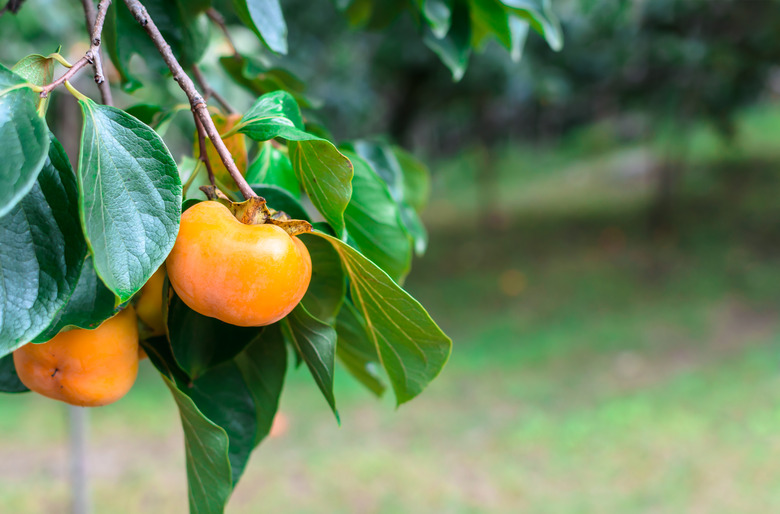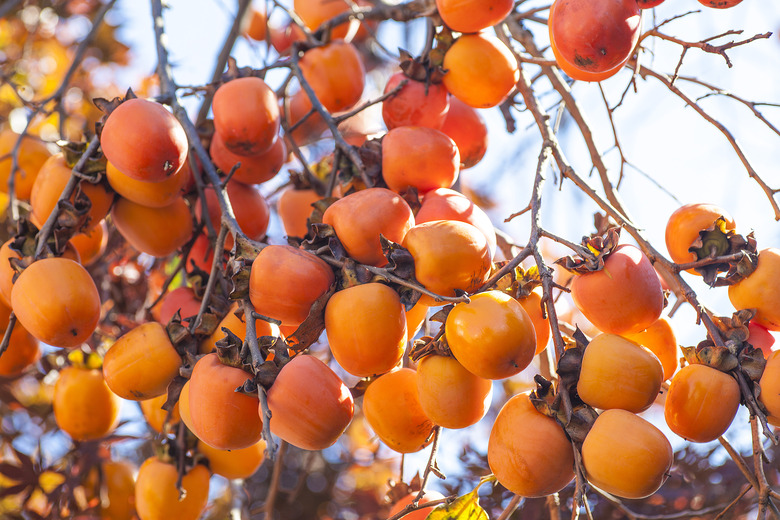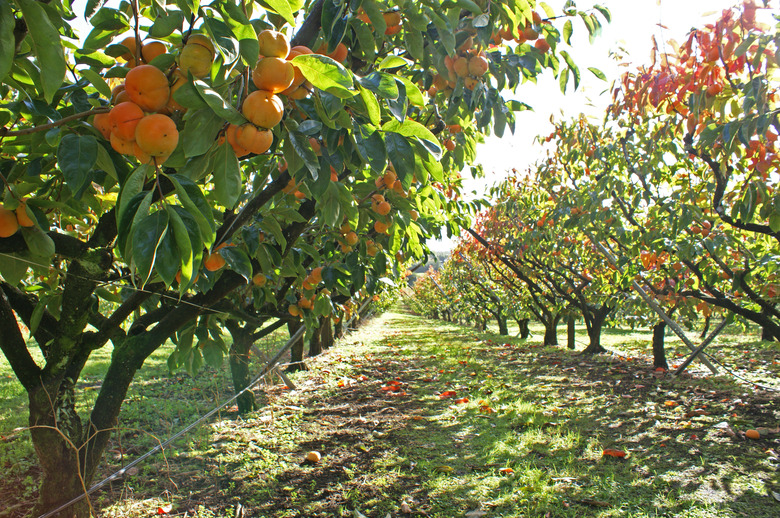How To Grow Persimmons
There isn't a lot of middle ground with persimmons (Diospyros spp.), and people tend to love them or hate them. If you hate them, you may want to consider trying them again. Persimmons come in astringent and nonastringent varieties. If you eat an astringent fruit too early, it will taste terrible and will make your mouth pucker faster than sucking on a lemon. Try again with a riper fruit, and you may find that you actually enjoy the sweet fruit of the persimmon tree.
If you do decide you love persimmons, the next hurdle you'll need to overcome is finding them. Some grocers do carry persimmons, but the fruit typically doesn't tolerate shipping well, leading some stores to abandon them altogether. Fortunately, you can easily grow your own persimmon tree so you'll always have your own supply.
Best Uses for Persimmons
Best Uses for Persimmons
Persimmons look like the product of an affair between a tomato and a pumpkin, but they don't taste like either. Slightly jellylike in texture, persimmons have a honeylike taste with just enough zest to keep them interesting without overpowering your taste buds. Persimmons somehow manage to be both sweet and tangy but not so zippy that they're tart. There is nothing else quite like them.
You can eat the versatile persimmon raw, or you can scoop out the fruit and use it to make pies, tarts, cookies, breads, and puddings. They make a wonderful topping for ice cream, waffles, and pancakes as well. Once your tree starts bearing fruit, you can depend on it for 1 to 2 bushels of persimmons every season.
This delightful fruit is the primary reason that home gardeners grow persimmon trees, but a tree can also add beauty to your landscape. Persimmon trees have rich, glossy leaves in the summer months followed by creamy white flowers and bright reddish-orange fruits. These stunningly colored fruits often hang on the tree in the fall longer than the leaves do, making an interesting visual effect as winter begins.
There are several different persimmon species, but the two most often grown in United States home gardens are the native American persimmon (Diospyros virginiana, USDA zones 4-9) and the Asian persimmon (Diospyros kaki, zones 7-10). The native American persimmon is cold-hardy to zone 4, which allows more gardeners to grow this tree, but Asian persimmons boast some of the only self-pollinating cultivars, allowing you to get fruit with only one tree.
Native American persimmon trees potentially grow 80 feet tall with a canopy spread of about 35 feet, while the Asian persimmon reaches 30 feet with 25-foot spread. Persimmons easily live for 60 years or more, and many make it to well over 100 years. Choose your planting spot carefully since your tree will be with you for a long time.
How to Grow Persimmons
How to Grow Persimmons
Starting a Persimmon Tree From a Sapling
Starting a Persimmon Tree From a Sapling
When you visit the garden center, you may notice that persimmon trees cost a bit more than other types of fruit trees. This is because persimmons are notoriously difficult to propagate. It's best to leave this process to the experts and buy an already-grafted tree even if it stretches your budget a bit.
Choose your new tree carefully. Most of the Japanese persimmon fruits are nonastringent, but a few of them are not. Make sure you choose a nonastringent variety so you don't have to wait as long to enjoy the fruit of your labor each season. You'll only need one Japanese persimmon to get fruit, but your tree will produce more if you plant a second.
Persimmons have a deep taproot, so you'll need to loosen the soil in the planting area to keep your tree happy. Dig your hole four times the width of the tree's root ball and one-and-a-half times as deep. Build a small dirt mound at the bottom of your planting hole, set the tree on top of it, and backfill the hole. If your soil is very heavy, amend the soil over the entire planting area by incorporating compost or other organic matter into the native soil. Water your tree deeply after planting. When planting multiple trees, space them at least 15 to 20 feet apart.
Note that the roots of persimmon trees are frequently black. If you see black roots while planting your tree, don't let it alarm you. This is perfectly natural.
In What Zone Do Persimmons Grow Best?
In What Zone Do Persimmons Grow Best?
Like other fruit trees, persimmons produce best when they experience a bit of cold weather, known as chill hours. Persimmons require fewer than 100 of these chill hours, but they do require some.
Ideally, you should grow them in an area where the winters are mild, although they can tolerate temperatures down to zero degrees Fahrenheit if they are completely dormant at the time. Once they start leafing out, however, temperatures as low as 26 degrees Fahrenheit will kill the new leaves.
Gardeners in U.S. Department of Agriculture plant hardiness zones 7 through 10 will have no trouble growing Japanese persimmons. Those in the colder zones of 4 through 6 may need to grow the more cold-hardy American persimmon.
When Should You Plant Persimmons?
When Should You Plant Persimmons?
The best time to plant a persimmon tree is early in the spring while the plant is still in its winter dormancy. This is particularly true for balled plants and plants in burlap. If your new tree came in a container, spring planting is still ideal, but you can get away with waiting until the summer to plant as long as you keep the container soil moist. Try to get your tree planted before hot, dry weather hits, though.
Soil, Sunlight, and Water Recommendations for Persimmons
Soil, Sunlight, and Water Recommendations for Persimmons
Persimmon trees require very little care once established. Simply plant them in full sun where the soil drains well and the pH is between 6.5 and 7.5. An established tree can resist drought if it must, but trees stay their healthiest and produce the best fruit when they remain evenly moist throughout the summer. Water only as needed to retain even soil moisture. If there's any doubt, skip the water and err on the side of providing too little water rather than too much.
Persimmons are not heavy feeders, and it's possible to overfertilize them, causing fruit drop. If you know your soil is poor, you can fertilize your tree with a balanced 10-10-10 fertilizer once in the early spring and again in midsummer. Apply 2 ounces of fertilizer per year of the tree's age. Instead of guessing, it's always best to have the soil tested for an accurate diagnosis of the nutrient needs or excesses.
Another school of thought in the persimmon gardening world is to skip the fertilizer altogether. Persimmons generally don't need it, and they will adapt to the soil you give them. This theory says you should let your tree get used to the soil you have rather than getting it used to nutrients you may not want to keep giving it for the duration of its long life span.
Like fertilizing, pruning persimmons is also a bit of a debate. You should, of course, prune away any dead or diseased limbs. Other than that, persimmons require little to no pruning. You can cut crisscrossing or overlapping branches out of your tree, but it will be fine if you choose not to do so. If you do prune the tree, do so during its winter dormancy.
When growing a persimmon tree, know that they have two habits that new gardeners may find unsettling. The first is fruit drop. When persimmons start to form on your tree, don't be surprised if some of the immature fruit falls to the ground. If the tree produces more fruit than it can handle, it will eliminate some and concentrate on growing what's left.
It's also of note that the persimmon trees often begin to leaf out later in the spring than other deciduous trees. If the rest of your garden is turning spring green but your persimmon isn't, don't worry. Just give it a little more time and trust that it will catch up.
How to Winterize Persimmons
How to Winterize Persimmons
As long as you buy the right persimmon species and cultivar for your growing climate, your persimmon tree will drop its leaves and put itself into dormancy for the winter. The process requires no help from you except for a little cleanup.
It's important that you rake up all the fallen leaves around your persimmon tree at the end of autumn or early in winter. If you don't, the leaves can provide cover for insect pests and fungi, which can attack your tree in the spring. Persimmons generally have very few problems with these issues, but it's still better to be safe than sorry that you overwintered something nasty.
How to Harvest Persimmons
How to Harvest Persimmons
Persimmons are a fall crop, generally ripening in September and later in warmer climates. Many trees continue to produce persimmons well into winter. American persimmons are smaller, but Asian persimmons should be about the size of a peach when they're ready and will have lost their green color in favor of an orange hue. When exactly you harvest them, however, depends on what type you planted.
Most Asian persimmons are nonastringent. These persimmons are collected and eaten while they are still somewhat firm. If you've planted an astringent variety, however, you'll need to wait and harvest your fruit when it turns soft and jellylike to the touch. Picking these persimmons too soon results in a bitter, unpleasant taste. You'll need only one bite to confirm that these fruits aren't quite ready.
To remove the persimmons from the tree, cut them off cleanly with a pair of pruning shears. They don't tend to pull off the tree easily, and you could cause damage if you pluck rather than cut. Once harvested, you can store persimmons in the refrigerator for about a month or freeze them for about eight months.
If you're growing American persimmons, they'll naturally fall from the trees when ripe; in fact, the tall height of the trees makes it impossible to harvest the fruit yourself. Another plus is that they'll be sweet with no astringency left when they fall from the trees.
Common Pests and Other Problems for Persimmons
Common Pests and Other Problems for Persimmons
The Japanese persimmon tree is not native to the United States. As such, it has very few natural pests here. Because of this, garden experts generally don't recommend any pre-emptive insect treatments for persimmons. You should instead wait to address insect issues only if/when you have them.
The persimmon borer is the exception to this rule. Talk to your local garden center and find out if these insects are common in your area. If they are, you'll want to treat your tree with a borer-killing insecticide.
As always, scale, mealybugs, and aphids may visit your plant. You can spray these pests off the tree with a jet of water or smother them in insecticidal soap if they appear in large or bothersome numbers. Stink bugs can also prove to be problematic, but you can kill them using any pesticide that will kill borers.
Deer, raccoons, and opossums have also been known to steal persimmons from unwary gardeners. If they do, you can keep them out of the tree by placing a 1-foot-wide metal collar around the tree trunk to discourage climbing. But once the fruits hit the ground, they're fair game!
Common Diseases for Persimmons
Common Diseases for Persimmons
Persimmons suffer from no unique diseases, but they are susceptible to viruses and bacteria just like other plants. In the U.S., home gardeners most often find themselves doing battle with crown gall or anthracnose.
Crown gall appears as small, round growths on the tree's branches and stems. As the disease increases in severity, the tree will eventually produce distorted leaves and fruit. The bacteria that cause crown gall enter the plant through an injury, so you can avoid the disease with proper tree care. Keep lawn mower blades and string trimmers well away from the tree and prune the tree only during winter dormancy.
There is no cure for crown gall once it has infected a tree. You can try to control the disease by pruning away infected areas. If the damage becomes too severe, however, you may need to remove the entire tree and destroy it.
Anthracnose is a fungal disease that causes black spots to form on the plant's leaves, twigs, and fruit. The disease targets new growth first and most often occurs during unusually wet springs. If left untreated, anthracnose will cause the leaves on the tree to fall off, starting at the bottom.
Like crown gall, anthracnose can often be avoided. To do so, rake up the leaves from under the tree and keep the garden free of debris. If your tree becomes infected with anthracnose in spite of your prevention efforts, prune away the infected parts of the plant and treat it with a copper fungicide spray.


